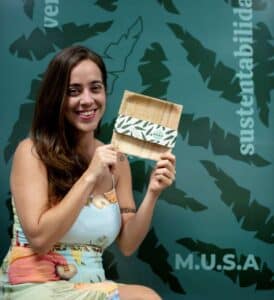Paula Facó, sold soups on weekends, as she always looked for sustainable alternatives to replace plastic packaging from Ceará.
The opportunity to develop a product for this purpose arose by chance after she was selected through the Public Notice of the Creation Laboratory of the School of Social Gastronomy Ivens Dias Branco.
Once mentored by an analyst at the Biomass Laboratory at Embrapa, Adriano Mattos, the woman from Ceará created a biodegradable dish made from residues from banana production.

Since research for the development of the piece was produced in 2019. Paula worked for seven months in search of a simplified sustainable production process.
Feedstock
In this way, the banana pseudostem was chosen as the raw material for making the dish of the MUSA line (Sustainable Food Materials and Utensils).
In fact, the genus of banana trees Musa soon after gave rise to the name of the project, which was built with products from organic banana plantations in the quilombo. North East.
As a reward for the work carried out in the community, Paula will promote several workshops for the residents of the quilombo of Ceará.
So much so that the topics covered: production of breads; alternatives for two main inputs produced in the region, banana and jackfruit; a mini-course on sales on social networks.
Now, in addition to Paula, seven researchers, selected through the Public Notice of the Laboratory of Creation in Food Culture and Gastronomy, worked on projects related to different themes.
Sustainability
As an example to give you an idea, Isaac Moreira worked on a “Tempero Cearense” obtained from string beans with papaya.
Iury de Melo created products from the full use of artisanal fishing inputs.
Mateus Ferreira highlighted the production of batiputá oil in the Tremembé indigenous community of Barra do Mundaú, in Itapipoca.
Fernanda Soares created a fermented vegetable cheese from cashew nut residues.
Vicente Monteiro developed ferments from the Caatinga biome and finally Marina Antonácio developed a manual for creating zero waste kitchens.


